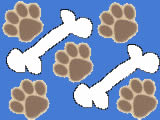General Principles For Puppy Training
Knowing a few basic facts about canine behavior and how to care for your new dog will help you establish a good relationship. Take time to learn about caring for your new dog and his safety. This will make the homecoming easy on both of you.
- Have a bed ready for the dog to use; a place to which it can retire and that is always reserved just for him. This can be an appropriately sized pillow, carpet remnant, thick pad, etc. A tie-down or crate is also suggested.
- Equipment: leashes come in leather, nylon and cotton; collars come in nylon and leather (choose a collar with a buckle, not a quick-snap closure, as buckles are less likely to come undone); choke chain (for correct sizing, measure your dog’s neck and add 2 ½” to 3”); muzzle of good quality for emergencies.
- One dish for food and one for water. They should be elevated so they are just under the dog’s chin. This helps with proper bone posture and helps prevent cartilage and muscle from bending in the wrong places.
- Identification tag: An ID tag should be permanently attached to your dog’s collar. It should have the dog’s name, your name, address and phone number with area code. You can also get a second tag with your veterinarian’s name, address and phone number on it.
- Grooming tools: The supplies you buy will depend on whether your dog has a short or long coat. For short-haired dogs, use a brush with natural bristles, a rubber curry
comb or hand mitt. For long-haired breeds, a normal hairbrush with a strong handle, wide-tooth metal comb and perhaps a mat splitter are needed. Be sure to include a flea comb regardless of the coat length. - Make sure your yard is dog secure. Check your fence for holes, loose boards or nails sticking out of the wood. Fix the fence and add wire or boards, if needed, to prevent digging, jumping or escaping. If you prefer, you can build a dog run.
- Dog-proof your home, inside and out. Dogs have a lower vantage point than ours and may be attracted to things you cannot see while you are standing up. Get down on your hands and knees to look for possible hazards. Confine your dog to a safe area inside and keep doors and windows closed or screened securely. Do not allow the dog to be left unsupervised inside or outside. This will prevent him from getting into mischief or soiling in the house. Keep your dog off balconies, upper porches or high decks. If you have a swimming pool, make sure your puppy or dog can’t fall in and accidentally drown. Secure cleaning supplies, detergents, paint and paint thinners, insect and rodent poisons, and anti-freeze. Remove hazardous household plants or place them out of your dog’s reach. Keep toilet lids down; the dog could try to drink or play in the water and get hurt by the lid closing on them or harmed by toilet bowl cleansers if swallowed. Puppies love to chew, so pay attention to electric cords, phone lines and similar hazards. Keep ribbon, sewing or knitting supplies out of your dog’s reach. They can easily choke on these items if swallowed. The same applies for nails, screws, paper clips, aluminum can tabs or other sharp objects.
- Show your dog where you would like him to relieve himself in a pre-selected spot outside before taking him back in the house. This usually means taking the dog to the spot you want him to use. If he doesn’t go, be sure to put him on a tie-down or in a crate when inside. When the dog asks to go out again, take him back to the pre-designated spot.
- Introduce your dog to his area as soon as you bring him home. Show him his bed, his toys, and where his food and water bowls are. Your dog will soon know which corner of the house is his. Be sure to take the dog on leash to allow you to correct if the dog tries to urinate in his new area. Give him rest and allow him time to explore and adjust to his new home.
- Keep the dog near you in order to make him comfortable in his new environment. This is a good time to use the crate or tie-down. Be sure the dog likes the place you pick for him to rest and be sure it will be a convenient and consistent spot. Try to put him where he can be seen, but is not in the main lane of traffic within the household.
One of the most important things you can do for your dog is establish a consistent routine that is easy and convenient for you to follow seven days a week. Dogs thrive on routine and adapt more easily to a new environment if there is an established schedule.






